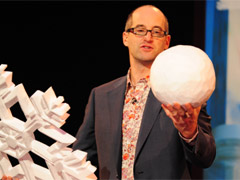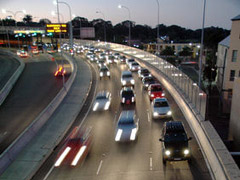
Why elephants can’t dance but hamsters can skydive
revealed in the Ri Christmas Lectures on BBC Four this Christmas
The historic Royal Institution Christmas Lectures will return to their home on the BBC this Christmas, airing on BBC Four on 28, 29 and 30 December. As well as explaining why an elephant wouldn’t make the grade on Strictly Come Dancing, the science lectures will reveal why hamsters can skydive without a parachute, why an ant can lift over 100 times its bodyweight, why chocolate is so amazing and how we could build a lift to the moon.
The Christmas Lectures will be a firm fixture in the Christmas calendars of families up and down the country. The Ri Christmas Lectures have been entertaining and educating children and adults alike since 1825 and have been an inspirational force for many budding scientists, including TV talent Dallas Campbell from Bang Goes the Theory, who took up a career in science after watching the lectures.
This year’s series will be given by Dr Mark Miodownik, a materials scientist from King’s College London, who will explore the extraordinary world of size and scale in the three part lecture series called ‘Size Matters’.
Dr Miodownik, an experienced science communicator, will travel from the microscopic world beneath our fingertips, to the tallest mountain on Earth and into the universe. Here is a sneak preview of some of the science he’ll be unraveling in the lectures:
• Why elephants can’t dance: Although they’re one of the biggest and most charismatic animals on Earth, elephants can’t dance because of their low area to volume ratio. Their legs are big and heavy to support their weight, but this impairs their ability to jump, change direction and dance, like an elegant ballerina.
• How hamsters can sky dive: The size of an animal determines its likelihood of surviving a fall from an aeroplane or a tall building. Smaller animals hit the ground with a proportionally lower force. That’s why, whilst falling out of an aeroplane is fatal for humans, hamsters live and spiders don’t even feel the impact. Don’t try this at home!
• Why chocolate tastes so melt-in-the mouth good: Chocolate melts in your mouth thanks to the crystal structure of the cocoa butter that is used to make it. The crystal structure is created when molecules fit together and build to make up the cocoa butter fat. Getting this crystal structure right is the trick and it’s not easy – there are six different crystal structures and only one works for chocoholics.
• Why ants are so strong: An ant can lift 100 times its own body weight compared to an Olympic weightlifter, who can only lift double their own weight on a good day. This is because, being so light, ants only use a small amount of their muscles to hold themselves up, leaving the rest of their strength for lifting. So, as things get bigger they get proportionally weaker.
• Can we build a lift to the moon? Until now there has not been a material strong enough to withstand the huge gravitational forces that dominate as you start to move up into space. But recently we discovered super strong materials, which make steel look as soft as butter by comparison, and which could indeed make it possible to build an elevator to the moon.
On giving this year’s lectures, Dr Miodownik said:
“I’m delighted to be delivering this year’s Ri Christmas Lectures on BBC Four. I watched the lectures when I was small and it feels amazing to be on the other side of the show. Hopefully, this year’s lectures will help inspire another generation of young scientists.
“There’ll be something for all the family to see and do, so tune in and join me on BBC Four this Christmas time.”


